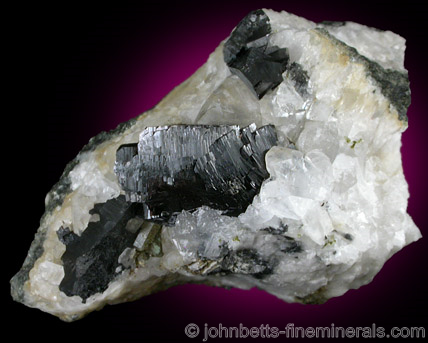The Mineral babingtonite

Babingtonite is a not a common mineral, and is usually associated with zeolites. It is found as small, dark, lustrous crystals on light-colored zeolites, creating specimens of strong contrast. Such specimens are much sought after by collectors. Recent findings in China have produced some very large crystals unlike any others previously known. Babingtonite sometimes pseudomorphs into other minerals, especially amphiboles as witnessed by the abundance of altered Babingtonite at Paterson and Prospect Park, New Jersey.
Chemical Formula
Ca2Fe2+Fe3+Si5O14(OH)
This is the formula for pure Babingtonite. However, it usually contains a small amount of manganese replacing some of the 2+ iron, and because of this its formula is sometimes written Ca2(Fe2+,Mn)Fe3+Si5O14(OH).
Color
Black, dark green, dark brown, bluish gray
Properties
Streak
Gray |
Hardness
5.5 - 6 |
Transparency
Opaque. Translucent in thin splinters. |
Specific Gravity
3.2 - 3.4 |
Luster
Submetallic |
Cleavage
2,2 - forming at an angle near 90º |
Fracture
Subconchoidal to uneven |
Tenacity
Brittle |
Other ID Marks
Occasional weak attraction to magnetic fields. |
Varieties
-
Mineral very similar to Babingtonite in which there is a greater content of manganese over iron over as the second element. Its chemical formula is Ca2(Mn,Fe2+)Fe3+Si5O14(OH). Manganbabingtonite is often regarded as a variety of Babingtonite, but it scientifically classified as a separate species.
Uses
Babingtonite is a rare mineral that is very much sought after by collectors.
Noteworthy Localities
Exceptional crystals, the largest in the world, come from Qiaojia, Yunnan Province, China. Another important Chinese locality of large crystals is the Hongquizhen Quarry, Meigu Co., in Sichuan Province. The Deccan Plateu basalts of India have also produced good lustrous crystals associated with Apophyllite and zeolites, especially at Nasik, Kandivali, Mumbai, and Poona, all in Maharashtra state.
European Babingtonite localities include Baveno, Piedmont, Italy; Arendal, Aust-Agder, Norway; and Grönsjöberget, Borlänge, Sweden.
In the U.S., the most notable occurrence is the Lane Quarry, Westfield, Hampden Co., Massachusetts. There are several other quarries in Massachusetts that have produced notable Babingtonite crystals, including the Cheapside Quarry, Deerfield, Franklin Co.; Blueberry Hill, near Woburn, Middlesex Co.; and Mount Tom, Holyoke, Hampden Co.
Very large crystals associated with Prehnite came from the Roncari quarry, East Granby, Hartford Co., Connecticut. The New Jersey traprock quarries, especially Paterson and Prospect Park, in Passaic Co. produce interesting rosette shaped Babingtonite aggregates, very often alter to bluish-gray Actinolite. Manganbabingtonite is well known from the Iron Cap Mine, Graham Co., Arizona.
Distingushing Similar Minerals
The mineral associations and occasional paramagnetism of Babingtonite make it distinct.